Chapter 13: Viruses, Viroids, & Prions
1/52
Earn XP
Description and Tags
These flashcards cover key concepts, vocabulary, and definitions related to viruses, viroids, and prions as discussed in Chapter 13 of the lecture notes.
Name | Mastery | Learn | Test | Matching | Spaced |
|---|
No study sessions yet.
53 Terms
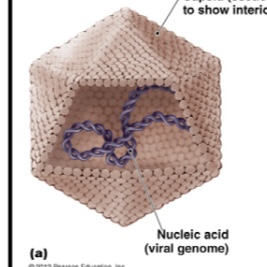
Virion
Complete, fully developed infectious viral particle.
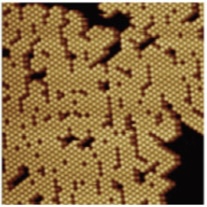
Capsid
Protective protein coat surrounding the viral nucleic acid.
Nucleic acid
The genetic material of the virus, which can be DNA or RNA.
Host range
The specific types of cells or organisms that a virus can infect.
Generalists
Viruses that can infect many types of cells across different hosts.
Bacteriophage
A virus that specifically infects bacteria.
Capsomeres
The protein subunits that make up the capsid.
Envelope
A lipid, protein, and/or carbohydrate layer around some capsids.
Spikes
Protein-carbohydrate complexes used for attachment to host cells.
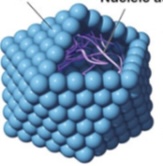
Polyhedral viruses
Viruses with many sides, with the icosahedron being the most common form.
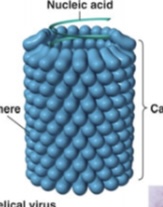
Helical viruses
Viruses that are shaped like long rods or cylinders.
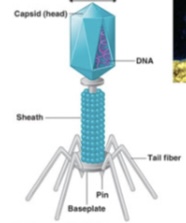
Complex viruses
Viruses with complicated structures that exhibit both helical and polyhedral characteristics.
Lytic cycle
A phase in viral replication where infected cells are lysed and destroyed.
Lysogenic cycle
A phase in viral replication where the phage DNA incorporates into the host genome and remains dormant.
Prophage
The dormant form of a phage when it integrates into the host chromosome.
Transduction
The process by which DNA is transferred from one bacterium to another by a virus.
Endocytosis
The process by which viruses enter host cells by engulfing them.
Budding
The process by which enveloped viruses are released from host cells.
Exocytosis
The process by which naked viruses are released from host cells.
Latent viral infections
Infections where the virus remains dormant in the host cell for long periods.
Cytopathic effects
Observable changes in host cells caused by viral infections.
Serological tests
Tests that detect antibodies against viruses in a patient.
RFLPs
Restriction fragment length polymorphisms, a method for analyzing DNA.
PCR
Polymerase chain reaction, a technique used to amplify DNA sequences.
Cultivation of viruses
The process of growing viruses in living cells
different techniques are required to grow and maintain viruses
techniques used depend on the normal host of the virus.
Animal viruses
Viruses that infect animal cells, often requiring different techniques for cultivation.
Embryonated eggs
Eggs used as a medium for growing animal viruses.
Cell culture
A method for growing viruses in isolated cells from an organism.
Taxonomy of viruses
The classification of viruses based on nucleic acid type, replication strategy, and morphology.
Viridae
The suffix used for naming virus families.
Virus genus
The category in virus classification that groups viruses with similar characteristics.
Prions
Infectious protein particles that cause neurological diseases.
Protein is an altered normal cellular protein
Inherited and transmitted by ingestion, transplant, and surgical instruments.
Spongiform encephalopathies
A group of neurodegenerative disorders associated with prions.
Creutzfeldt-Jakob disease
A human prion disease characterized by rapid neurodegeneration.
Mink encephalopathy
A prion disease affecting minks.
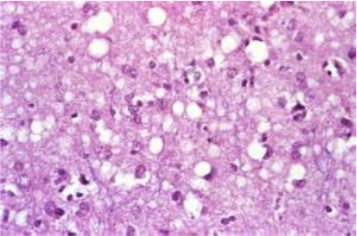
Bovine spongiform encephalopathy
A prion disease in cattle, also known as mad cow disease.
Fatal Familial Insomnia
A prion disease characterized by severe sleep disturbances.
Gertrudam-Straussler-Scheinker syndrome
A rare genetic prion disease characterized by ataxia.
Kuru
A prion disease observed in humans, historically linked to cannibalism.
Alpers Syndrome
A prion disease that affects infants, causing neurological dysfunction.
Oncogenic viruses
Viruses that can cause cancer in the host organism.
Zoonotic viruses
Viruses that are transmitted from animals to humans.
Immunoglobulin
Antibodies produced by the immune system to identify and neutralize pathogens.
Viral hemagglutination
A test that determines the ability of viruses to agglutinate red blood cells.
Cultivation of bacteriophages
Grown in either liquid cultures of bacteria, or in bacterial cultures on solid medium
Viruses can be detected by the formation of plaques
Cultivation of Animal Viruses
Animal viruses may be grown in living animals, embryonated eggs, or in cell culture
Observers see cytopathic effect-cell deterioration due to virus activity
Viral replication in the lytic cycle
Virus comes into cell, makes all viral products it needs, puts all viral products back together, then releases through host cell
Lysogenic cycle Viral replication
Replicates viral DNA but doesn’t cause cells to be destroyed, incorporated into genetic material and causes infection in lytic cycle
Replication of animal viruses process
Viruses attach to cell membrane, penetration by fusion, uncoats itself, makes viral products, puts them back together, then released and destroys host cells
Requirements for Replication of animal viruses
Requires different strategy depending on its nucleic acid
DNA viruses assemble in nucleus and RNA viruses develop solely in cytoplasm
Number of viruses depend on on type of virus and size and initial health of host cell
Enveloped viruses cause persistent infections
Naked viruses are released by exocytosis or lysis
3 ways animal viruses come in body
Endocytosis, membrane fusion, direct penetration which is the rarest
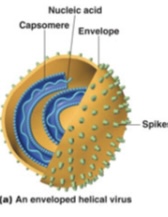
Enveloped viruses
Surrounded by an envelope roughly spherical
Can be helical or polyhedral
Viral species
A group of viruses sharing the same genetic information and ecological host.